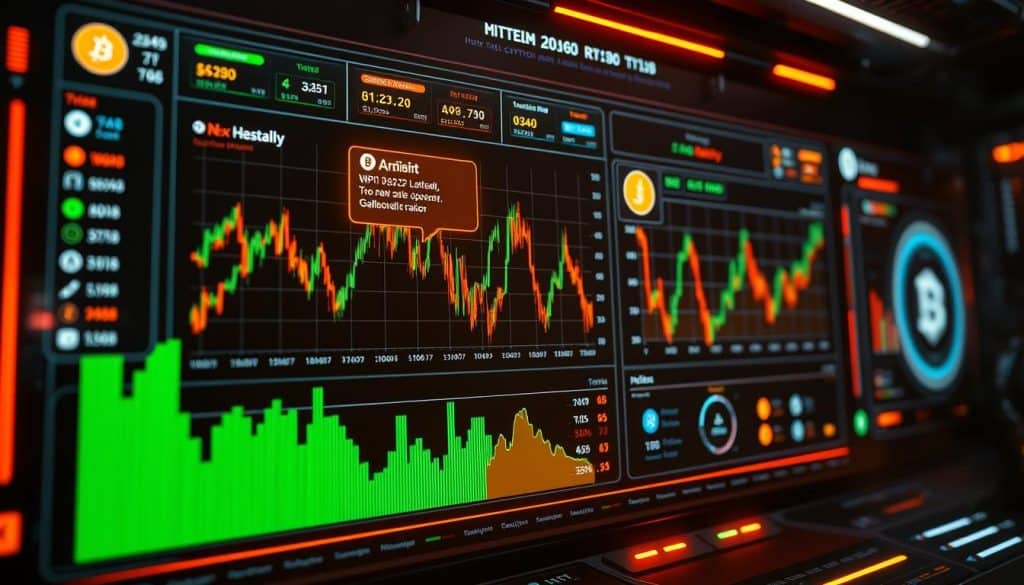Make Money Trading Crypto: Beginner’s Guide
The cryptocurrency market has been growing for over ten years. It’s now a popular way to earn money online. By 2024, more folks are planning to gain from the increasing value of cryptocurrencies such as Bitcoin and Ethereum1. This guide is here to help newcomers understand and thrive in this profitable area.
To earn from crypto trading, it’s vital to know the basics. You should learn about CFDs (Contracts for Difference) and spot trading on exchanges2. With high returns possible, having a detailed guide is key. It ensures you can seize opportunities and manage risks well.
Key Takeaways
- Cryptocurrency markets operate through decentralized digital currency networks2.
- In 2024, more people are seeking to make money by trading cryptocurrencies like Bitcoin and Ethereum1.
- CFD trading allows you to speculate on cryptocurrency prices without owning the coins2.
- Trading CFDs on cryptocurrencies involves leverage, potentially magnifying profits and losses2.
- There are multiple approaches to make money online with crypto, including trading, mining, staking, and more1.
What is Cryptocurrency Trading?
Cryptocurrency trading is about buying and selling digital currencies. You can trade through exchanges or speculate on price movements with contracts for differences (CFDs). Cryptocurrency markets don’t have a central control. They work across computers worldwide3. This setup makes transactions clear and secure. Everything is recorded on a blockchain, a digital ledger everyone shares3.
Definition and Basics
To trade cryptocurrency well, knowing the basics is key. With the right knowledge and strategy, trading can be very profitable. Crypto prices can change a lot within a day, sometimes by more than 10%4. This high volatility offers chances for traders but also demands careful risk management.
Several factors affect crypto prices. These include how much is available, the market value, news reports, and major events3. Beginners must choose to trade directly on an exchange, owning the tokens, or through CFDs. CFDs let you bet on price changes without owning the actual assets.
CFDs versus Buying on Exchanges
CFDs offer a different trading style than buying directly on exchanges. They let traders bet on price changes without owning the cryptocurrency. This way, you can make money from prices going up or down3. Trading with leverage, common in CFDs, means you can control big positions without full payment upfront. This could lead to bigger gains3.
But, owning cryptocurrencies directly means you have the tokens. This suits those planning to hold onto their digital assets for a long time. Exchanges are places to buy various cryptocurrencies. They support buying by offering different payment options, like wire transfers, which are usually less expensive5. They also enable direct investment and ownership4.
To aide you in your trading journey, consider the following comparative analysis:
| Trading Method | Ownership | Leverage | Initial Cost | Flexibility |
|---|---|---|---|---|
| Exchanges | Yes | No | High | Lower |
| CFDs | No | Yes | Low | Higher |
Why Trade Cryptocurrencies?
Trading cryptocurrencies comes with many benefits, appealing to both novices and experts. A key reason for trading in crypto is the chance to find significant opportunities. This is because digital assets often show strong volatility.
Volatility and Market Opportunities
The value of cryptocurrencies can change a lot quickly. This volatility is good for traders who want to make profits from fast price changes. They might do this through day trading or more long-term plans. By learning about market opportunities in crypto and using strategies such as technical analysis and assessing risks, traders can boost their chances of doing well6.
Crypto swapping is mainly about exchanging assets strategically, not just to make money. There are three main kinds: Centralized exchanges (CEXs), Decentralized exchanges (DEXs), and Automatic swap protocols. Each type has its own benefits, depending on your trading goals6.
Potential for High Returns
Another strong reason to trade cryptocurrencies is the chance for high returns. Cryptos are often less affected by things like the economy or politics, making for a unique and freer trading space. For example, Bitcoin has a limit of 21 million coins. This limit protects against inflation and may boost its value over time7. Also, cryptocurrencies usually have very low or no transaction fees. This makes them an effective option for sending money worldwide7.
Traders often try to make more money through actions like providing liquidity, yielding farming, and swapping tokens. This helps them make their investments more diverse6. Even though the value of cryptos can change a lot, the chance for high returns is a big pull for many traders8.
How to Make Money Trading Crypto
To earn from crypto trading, you need knowledge and smart strategies. Using good trading practices and strong risk control can really up your success chances in the crypto world.
Profitable Crypto Trading Strategies
Finding and using money-making crypto strategies is key to doing well financially. Techniques like day trading and swing trading, plus using derivatives such as CFDs, can help you get more from market changes. Yet, it’s important to remember these strategies can also increase losses if the market doesn’t go your way. For example, trading Bitcoin CFDs can mean big profits when prices go up, like when Bitcoin shot from $17,000 to $60,000 in 20219. Cryptos can change value by thousands in just a day, showing why a solid strategy matters10.
Risk Management Techniques
Managing risks in crypto trading means using techniques to protect your money from big losses. Setting stop-loss orders helps cap potential losses per trade. Limit orders let you lock in profits at your target price. Trade only with money you can afford to lose, given how unpredictable crypto prices are10. Also, remember the IRS taxes virtual currency gains or losses, so keep track of your trading for tax reasons11.
Staying up-to-date with market trends and rules is another key risk management part. For example, the SEC green-lighting Bitcoin ETFs has big effects on the market, requiring strategy adjustments9. Be on the lookout for scams, too, like the Uniswap phishing attack in July 2022, showing why securing your investments is critical10.
Choosing a Cryptocurrency to Trade
Choosing the right cryptocurrency is essential for trading success. You should look at market size, how easy it is to sell, price history, and growth potential. These factors are key.
Bitcoin and Ethereum are top picks for many traders. They are big in the market and many places accept them12.
Newer coins like Cardano, Solana, and Dogecoin are getting popular too. They offer unique features and tech advantages12.
Different exchanges offer various trading options. Kraken has more than 200 cryptocurrencies and fees that vary from 0.00% to 0.40%13. Coinbase, on the other hand, supports over 5,500 assets. Its fees go from 0% to 0.60% based on how much you trade13.
Crypto.com is another option. It works in 90 countries and has over 350 cryptocurrencies13. Gemini is good for experienced traders. It offers more than 80 digital currencies and tokens. Fees range from 0.0% to 0.40%13.
Here’s a comparative table of these exchanges:
| Exchange | Year Established | Cryptocurrencies Supported | Transaction Fees |
|---|---|---|---|
| Kraken | 2011 | 200+ | 0.00%-0.40% |
| Coinbase | 2012 | 5500+ | 0%-0.60% |
| Crypto.com | 2016 | 350+ | Up to 0.075% |
| Gemini | 2014 | 80+ | 0.0%-0.40% |
To pick the best crypto for trading, understand these points. Keep up with market trends and exchange details. This way, you’ll trade the best cryptos that meet your goals.
Setting Up Your Crypto Trading Account
Starting your journey in cryptocurrency trading begins with setting up your account. There are different accounts for various trading styles.
Exchange Accounts
Exchange accounts are for those wanting to own cryptocurrency. Brokerages like eToro, Coinbase, Kraken, and WeBull are great for newbies14. You will need to create an account, verify your identity, and add funds. To keep your investments safe, think about using Coinbase Wallet or a Ledger wallet for extra security14.
CFD Trading Accounts
CFD trading accounts are for profiting from price changes without owning the crypto. This option involves betting on price moves with CFDs. They’re quicker to set up and need less money to start but have their own risks and might cost more. eToro and WeBull are top choices for their simplicity and security14.
Choosing between an exchange or a CFD account depends on your goals and how much risk you can handle. By picking the right account, you’ll take an important step into the exciting world of crypto trading.
Exploring Different Crypto Trading Strategies
Venturing into cryptocurrency trading is thrilling and challenging. There are various strategies for different trading styles. Knowing these strategies is key, whether you like quick short-term trades or long-term investments.
Day Trading
Day trading is quick. You buy and sell within the same day to make short-term profits. This requires understanding technical analysis. Tools like candlestick patterns and moving averages help predict price moves in crypto15. Cryptos trade on decentralized markets, allowing day trading without traditional stock exchange limits16.
Swing Trading
Swing trading means holding positions for days or weeks to catch market moves. It’s great if you can’t watch the market all the time. Swing traders use cryptocurrency price changes to make profits over time. News, e-commerce payments, and big events affect prices16. Bitcoin’s limited supply also plays a role15. Swing traders use technical analysis to find the best times to buy and sell.
Margin Trading
Margin trading lets traders borrow money to increase their investment. This can lead to bigger profits or losses. So, understanding how to manage risks is vital. Traders mix their strategies to protect against losses16. Using stablecoins like Tether (USDT) can help manage the market’s ups and downs15. It’s important to match your trading strategy with how much risk you can handle16.
Looking at these strategies helps you make smart choices in crypto trading. Whether you want quick profits or prefer the long-term approach, it’s about finding what works for you.
Understanding the Crypto Market
Learning about the crypto market means getting to know how to analyze it. It’s about seeing how supply and demand change things. To make smart choices, you look into both the technical details and the big picture.
Market Analysis Techniques
Technical analysis helps predict where the market might go. It uses charts and tools to look at trends. Bitcoin, created in 2009, is a key trend indicator17. On the flip side, fundamental analysis digs into a cryptocurrency’s real worth. This includes its tech, uses, and legal aspects. Ethereum, for instance, is prized for running apps and contracts without a middleman17. Using both methods gives a clearer market picture.
Supply and Demand Factors
The balance of supply and demand sets crypto prices. Supply involves how many types of cryptocurrencies exist. As of mid-2024, there were over 10,00018. Coins like Bitcoin and Ethereum are part of this count18. Demand grows with good public opinion, more users, and news coverage. Cryptos like Binance Coin and Solana show how new tech can boost demand17. Knowing these elements helps traders predict and respond to market changes.
Best Platforms for Trading Crypto
Starting your journey in cryptocurrency trading? Choosing the right platform is key. Whether you prefer major crypto exchanges or specialized CFD providers, your choice will shape your trading experience.
Top Cryptocurrency Exchanges
Coinbase, Gemini, and Binance stand out for their easy access to a wide array of cryptocurrencies. They also offer strong security measures.
- Coinbase has a trading fee range of 0% to 3.99%. It offers over 240 cryptocurrencies19 and up to 12% APY in rewards19.
- Gemini’s fees range from 0.5% to 3.49%, with access to over 70 cryptocurrencies19. Its rewards program, Gemini Earn, was adjusted after a freeze in November 202219.
- Kraken’s fees vary between 0.16% and 5%, with over 200 cryptocurrencies available19. It offers about 100 crypto pairs19.
- Binance is known for its low fees and supports over 350 cryptocurrencies20.
- Crypto.com charges between 0% and 2.99% for trading, with more than 350 cryptocurrencies on offer19.
Each exchange offers something special. For example, Binance is great for those who trade a lot because of its low fees. Coinbase might appeal to those looking for high rewards from their investments.
CFD Providers
CFD providers let you trade on crypto prices without owning them. PrimeXBT and Bybit are notable providers in this space.
- PrimeXBT offers up to 200x leverage and supports various assets20.
- Bybit is great for advanced traders with its margin trading and futures20.
- Interactive Brokers, though mainly for stocks, also offers Bitcoin and other cryptocurrencies21.
| Platform | Trading Fees | Available Cryptocurrencies |
|---|---|---|
| Coinbase | 0% to 3.99% | Over 240 |
| Gemini | 0.5% to 3.49% | Over 70 |
| Kraken | 0.16% to 5% | Over 200 |
| Binance | Lowest in Industry | Over 350 |
| Crypto.com | 0% to 2.99% | Over 350 |
| PrimeXBT | Dependent on Leverage | Various Assets |
| Bybit | Varies | Specialized in Futures |
Both exchange types have their upsides. If you want to own a wide range of cryptocurrencies, Coinbase and Binance are great. For those who like margin trading, PrimeXBT and Bybit could be better picks.
Analyzing Crypto Price Movements
For traders, grasping crypto price movements is essential. It involves technical and fundamental analysis. These analyses offer deep insights into market conditions. They help predict where prices might go.
Technical Analysis
Technical analysis uses chart patterns and statistical indicators. This helps predict future crypto prices. Understanding market trends and their effects on prices is key for trading decisions22. Line charts, bar charts, and candlestick charts are tools for this analysis22. By examining these charts, trends and patterns emerge22. Indicators like the Moving Average Weighted (MAW) and Relative Strength Index (RSI) reveal price changes over time. They assist in making smarter investment choices23.
Fundamental Analysis
Fundamental analysis looks at the bigger economic picture. It reviews tech advancements, adoption rates, and regulations affecting a cryptocurrency’s value. Bitcoin’s surge to over USD 65,000 is an example of market dynamics at play23. Understanding a cryptocurrency’s community and the project team’s track record is important too24. It sheds light on potential growth or risks24. Ultimately, evaluating a project’s vision and leadership predicts its market stability and price movement24.
Managing Risks in Crypto Trading
Handling risks in crypto trading is key to protect your money and win in the long run. By using the right tools and strategies, you can really improve your trading results. Let’s look at some important ways to manage risks.
Setting Stop-Loss and Limit Orders
A simple but powerful method to manage risk is through stop-loss orders. These orders sell your crypto if the price falls to a set level, limiting potential losses. Limit orders are similar, locking in profits by selling when the price hits a certain point.
It’s smart to have a risk/reward ratio, aiming for your reward to be twice your risk. Keeping a 2:1 ratio helps traders be disciplined and make better choices25. It’s also important to be careful with leverage, as it can increase losses26.
Diversifying Your Portfolio
Spreading your investments in various cryptocurrencies is crucial for risk management. Instead of just investing in one, having your assets in multiple digital currencies reduces risk. If one asset’s value drops, it doesn’t greatly hurt your whole portfolio25.
By diversifying in different cryptos or strategies, you lower the chance of big losses from a price drop. Choosing a trading platform with a good reputation, like KuCoin, helps manage risks better25.
| Risk Management Technique | Description | Benefits |
|---|---|---|
| Stop-Loss Orders | Automatically sell crypto at a predetermined price | Limits potential losses |
| Limit Orders | Sell crypto when price reaches a target | Locks in profits |
| Diversifying Investments | Invest across multiple cryptocurrencies | Reduces risk by not overexposing to one asset |
Integrating Security Measures
In the world of crypto trading, keeping your investments safe with strong security is crucial. Knowing and using these steps can greatly lower the chance of cyber-attacks.
Two-Factor Authentication
One top method to keep your accounts safe is Two-Factor Authentication (2FA). It ensures extra safety by needing two types of ID before getting in. Yet, 199 crypto theft cases in 2022 show the need for even stronger security27. Using tough passwords and changing them often, along with 2FA, boosts your safety28.
Using Secure Wallets
Choosing crypto wallets wisely is key to protecting your digital money. Hardware wallets keep your private keys safe offline, making hacking much harder27. The $570 million stolen from Binance shows how vulnerable online platforms can be27. So, mixing offline and online wallets is a smart choice for the best protection.
Comparative Table: Security Measures
| Security Measure | Effectiveness | Implementation |
|---|---|---|
| Two-Factor Authentication | High | Through exchange/platform settings |
| Hardware Wallets | Very High | Purchase and store offline |
| Cold Storage Solutions | High | Use for long-term holding |
| Regular Security Audits | Moderate to High | Engage security professionals |
| User Education | Moderate | Continuously learn about threats |
Security in crypto trading is super important. By using methods like 2FA and secure wallets, you make a big move towards keeping your money safe. Staying updated and following the best tips are key to a safe crypto experience.
Monitoring Your Trades
Keeping track of your trades well is key to doing great in the crypto market. Tools that show live prices and alerts are very useful. They help you know what’s happening right now in the fast-moving crypto world. Platforms like Binance let you watch many trading pairs. These pairs can jump in value by 10% to 800% in a day29.
Real-Time Pricing and Alerts
Using more than one screen lets traders see lots of info at once. This includes what the market’s doing, keeping an eye on current trades, and finding new chances to trade30. With at least three monitors, you can watch important charts. This can really help keep track of your trades30.
Watching live data helps you respond quickly to what the market does. The right setup of screens gives you an advantage for successful trading. It helps build a lasting strategy30. It’s smart to watch various big-name stocks and gold shares too. This helps you see the bigger market trends.
Closing Positions at the Right Time
Knowing when to close a trade is vital to make money or stop a loss. Binance users might look for small daily increases, like 10% to 20%, for regular profits29. This means always watching the market and sticking to your trading plan.
Choosing the right time to exit trades matters a lot. Study the patterns and trading volume on exchanges like Binance29. This helps pick pairs that might do well. To keep things stable, you might trade with stable coins like USDT or GBP29.
Having a well-set-up screen setup speeds up tough trading choices. This reveals situations that could lead to big market moves30. Day traders, who make many trades a day, know how crucial a good setup is. It makes trading a lot more efficient30.
| Trading Strategy | Recommended Tools | Benefits |
|---|---|---|
| Day Trading | Multiple Monitors, Real-Time Pricing Tools | Facilitates rapid decision-making and better market observation |
| Swing Trading | Chart Analysis, Market Movement Securities | Helps capture medium-term market trends for more informed trades |
| Scalping | High-Frequency Alerts, Position Management | Optimizes quick trade executions for small but frequent profits |
HODLing and Long-Term Investment
The term HODLing came from a funny mistake in an online forum chat on December 18, 2013. It has turned into a key philosophy among those who love crypto31. “Hold on for dear life” is what it means as it promotes a stay-put investment mindset in crypto31. It’s really different from fast-paced trading, highlighting the worth of patience and trust in the future value of cryptocurrencies.
Being patient is at the core of long-lasting crypto investment ideas. It’s not about quick buys and sells like day or swing traders do. Here, it’s about sticking with your assets for a long time, sometimes years32. This method shows faith in the true value and future growth of the investment.
Take Bitcoin’s growth from around $130 in April 2013 to over $950 by the end of that year. It proves how HODLing can result in big wins31. When picking cryptocurrencies to keep for the long haul, investors weigh key aspects like how the currency works and its role in decentralized networks32. Understanding these aspects helps in making choices that could grow in value over time.
Also, there are perks to keeping your tokens. For instance, HODL Coin on the Binance Smart Chain rewards those who HODL with Binance Coin (BNB) payouts every three days31. This kind of reward encourages investors to hold on longer, adding an extra benefit to the HODLing strategy.
| Investment Strategy | Characteristics | Suitable For |
|---|---|---|
| HODLing | Holding assets for months to years, focusing on long-term appreciation | Investors with high patience and belief in long-term value |
| Day Trading | Frequent buying and selling within the same day | Investors seeking to capitalize on short-term market volatility |
| Swing Trading | Holding assets for days to weeks, blending short-term and long-term strategies | Investors looking for intermediate-term gains |
The investment plan you go for depends on what you want financially, how you feel about risk, and how you see the market. But for many, HODLing is a solid base, especially for those who believe in crypto’s future growth potential3132.
Conclusion
As you finish the “Beginner’s Guide to Make Money Trading Crypto,” we’ll review key points for success. Cryptocurrency trading offers chances but demands research, planning, and risk understanding.
One key insight is knowing the trading strategies: day trading, swing trading, and investing long-term. Day trading makes many trades in a day for quick profits33. Swing trading holds trades for days or weeks, aiming for bigger movements. Your strategy should match your financial goals and risk level.
Understanding market tools is also vital. Use tools like moving averages and RSI to see market trends. Set up risk management steps carefully34. Know your risk limit, work out risk-reward ratios, and use leverage wisely. High leverage can lead to big profits or losses, so make smart choices.
Lastly, keep up with market changes. Guides like this one are a great start, but learning never stops33. Talk to experts, join the community, and pay attention to taxes on crypto earnings. With these tips, you’re ready to dive into the exciting world of crypto trading.






